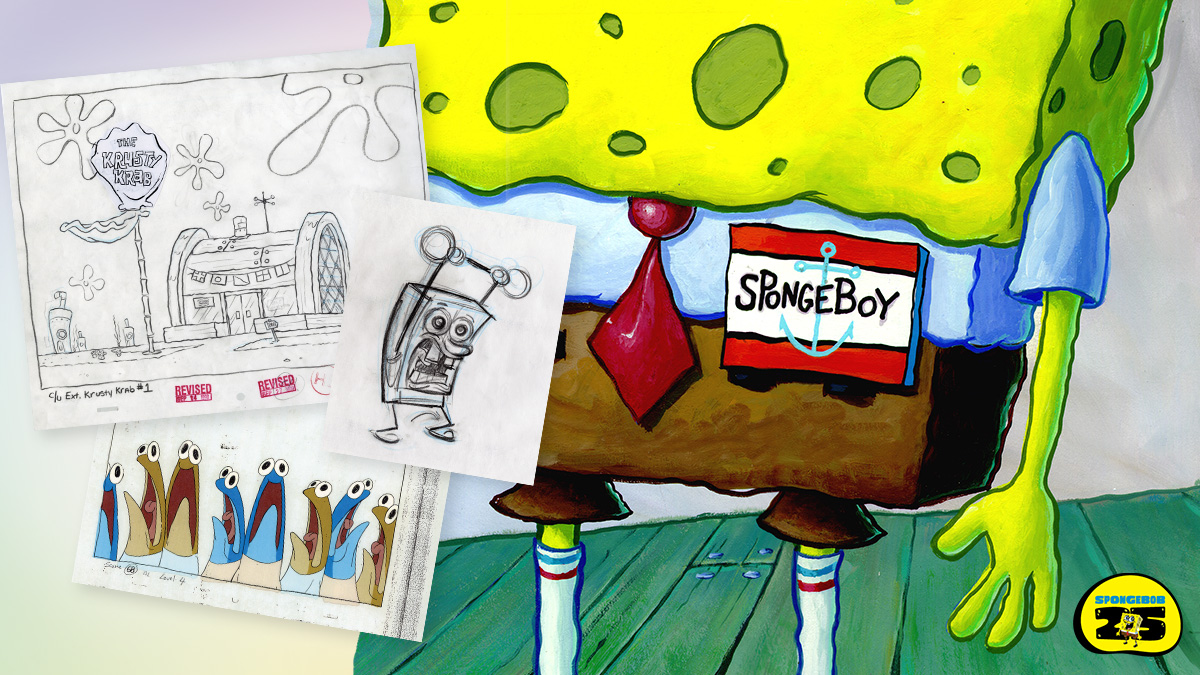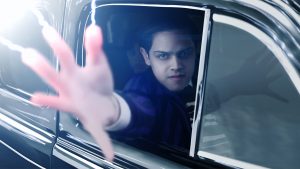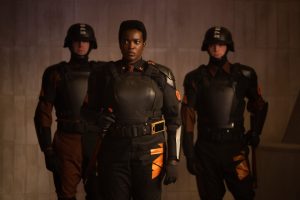
This article is presented by
Starting a new job brings an interesting mix of emotions—the rejuvenating promise of a fresh start mixes with the anxiety that several unknowns produce. You hope you like your boss, that you gel with your coworkers, and the gig lasts long enough to provide stability. Few people go into their first day thinking they are settling in for a quarter-century run of a lifetime.
SpongeBob SquarePants debuted on May 1, 1999 with “Help Wanted,” an eight-minute introduction to creator Stephen Hillenburg’s animated aquatic wonderland. The pilot introduces viewers to the world of Bikini Bottom and some of its most iconic characters—the curmudgeonly Squidward Tentacles, money-obsessed Mr. Krabs, village idiot Patrick Star, and the titular, childlike SpongeBob, finally ready to apply for his dream job as a fry cook at the local burger joint, The Krusty Krab.
SpongeBob isn’t the only person who landed a dream job with “Help Wanted,” as voice actors Rodger Bumpass, Clancy Brown, Bill Fagerbakke, and Tom Kenny (Squidward, Mr. Krabs, Patrick, and SpongeBob, respectively) were also submerging themselves in a new venture that would change their lives, the world of animation, and pop culture itself, forever.
The following interviews were edited and condensed for clarity.
Getting Their Feet Wet
While the voices behind the “core four” had experience in voice acting, they each came to SpongeBob SquarePants with differing expectations and levels of investment.
TOM KENNY: I had worked on Rocko’s Modern Life, a Nickelodeon series created by Joe Murray. I was doing stand-up at the time. I was trying to break into voiceover, especially animated voiceover, which was my dream job.
Carlos Alazraqui, the voice of Rocko, was also a stand-up comedian. Joe Murray said, “Is there anybody funny that would be good for [Rocko character] Heffer?” And Carlos said, “Yeah, there’s this guy, Tom Kenny.”
So I met with Joe, and he hired me to be Heffer. Then, on that show, the creative director was Steve Hillenburg. Joe Murray put together this amazing crew of guys just getting their feet wet in the animation business. That’s where I met Steve and a lot of the other SpongeBob builders.
CLANCY BROWN: I had been working in voiceover a little bit. I had sort of put my toe in and decided that I really liked it. I had done a couple of series that didn’t last very long. But I knew I liked doing it. It was a good gig. I got a call: “Would you come and do this thing?” I said, “What kind of voice is it?” And they said, “It’s this kind of a character voice. It’s a crazy Nickelodeon show.” [Animation Studio] Klasky Csupo was doing a lot of Nick’s shows then, and this wasn’t Klasky Csupo. I had a friend who was writing on Hey Arnold!, so I called him up and said, “What’s the story?” And he goes, “I know it’s going to be good.”
KENNY: Steve was ready to pitch his own show. He was kind of working on this thing in his spare time. He invited me to his small rented apartment in West Hollywood and showed me the show bible. It was all there. He showed it to me, and I just fell in love with it.
He was like, “I want you to be SpongeBob. You know, you kind of are SpongeBob: hyperactive, work your ass off, always trying to look at the sunny side of things.” He intuited all that stuff from knowing me. So I had the gig from the get-go, which is very unusual.
But Steve did say to me [the network] is kind of pushing for Fred Savage because The Wonder Years was really big at that time, and I thought, “Oh well, it was nice while it lasted.” He said, “Oh no. You’re SpongeBob. You laugh like him, you think like him, you cry like him. You’re SpongeBob. It’s not going to be anyone else.”
BILL FAGERBAKKE: Coach had ended in ’97. I was figuring out my own career. I kind of wanted to stay away from sitcoms. Animation had started for me around ’94 or something like that. I think [Hillenburg] heard some of my work on Beethoven and Gargoyles. I think that just opened his mind to me reading for Patrick.
RODGER BUMPASS: When SpongeBob hit, it was just another cartoon, another audition. Back then, you had to go to your agent’s office or the third-person casting place and physically get there and do the audition. And then you got the job. I got the job.
“I Guess This Thing Works”
The pilot was recorded in 1997 and was eventually picked up to series. Just like their journeys
to the show, the cast had varying reactions to their first visit to Bikini Bottom.
BUMPASS: We did the pilot. I got a copy of it, took it home to my family, played it for them, and they all fell asleep. So I just let it go and said it was just another cartoon. The only cartoon I’d ever been a part of that lasted any length of time was Where on Earth Is Carmen Sandiego? and that lasted for four years. I said, “Well, okay, this is another cartoon; it’ll last maybe a year or two or whatever.” Then I saw the snowballing reception we had from our fans. I was a little surprised. Pleasantly so, you might say.
BROWN: I was just trying to make sense of the pilot. I couldn’t quite grasp what was going on. The problem was, of course, that it was very obvious what was going on. It’s very simple. The key to SpongeBob, generally, is that the simpler, the better.
We went to the studio—it was a big room. Stephen started out in the booth. I’d never had a creator or a director sit in on the recording. In terms of having fun, it really did stand out. But the pilot itself, to me, was very strange.
When we finally got it animated, and it was going to air, they gave us a videotape. I took it back to my house and showed it to my daughter, who was then four years old, and said, “What do you think?” She was mesmerized by it. She wanted to watch it again. And she wanted to watch it again. And she wanted to watch it again. And I was like, “Okay, I guess this thing works.”
FAGERBAKKE: I didn’t really understand it. I was kind of dismissive of it. I thought it was like preschool stuff. I thought it was just going to be one [recording] session because you never know. You’re just trying to book one thing and do your best. It was really weird because there were anchovies in that episode. We had a tank of helium in the recording studio for us all to be the anchovies. I thought, “This is the craziest $600 I’m getting here.” It was fun. The people were cool. I just thought it was for little kids. I was happy to do it but I forgot about it.
And then 10 months later, I get sent a VHS video. Halfway through watching it, I was just blown away by this creation that Hillenburg had executed—this magic carpet of creativity and humor and wit and rhythm and characters weaving together to respond to each other in such a wonderful, engaging way. It was so great.
KENNY: When I saw the finished pilot, it was as funny as I had hoped it would be when I saw the storyboard—before I ever met any of these other actors or heard them voice the characters. It was every bit as funny and charming. I remember going home to my parents’ house in Syracuse, New York with a VHS copy of the pilot and playing it for my folks. They’re just regular folks, you know, blue-collar people. And my dad said, “That’s a really cute show. I think that’s really got a chance.”
Having a Wonderful Time
One element of the pilot that left an immediate impression on all of the cast members was the inclusion of a cover of the song “Livin’ in the Sunlight, Lovin’ in the Moonlight” by ’60s artist Tiny Tim.
FAGERBAKKE: By the time we hit Tiny Tim, my mind was shattered.
BUMPASS: It was genius using Tiny Tim’s music in the show. I wish we could have done it more often and have it be kind of a theme because it’s so silly. It fits our atmosphere and our energy so well.
BROWN: [Tiny Tim is] the perfect soundtrack. Rest in peace, Tiny Tim. Part of his act was that he was just so guileless. I love to believe that Tiny Tim was the person who we saw on stage. You know, because he would always bow and be so gracious. He was just as simple and sweet as SpongeBob is.
KENNY: [“Livin’ in the Sunlight, Lovin’ in the Moonlight”] was the perfect choice because it’s a song about loving life, loving the world, having the most fun that you can, sung by a personality who’s a total outcast, who’s a total oddball, who could never do anything other than what he wound up doing.
At first, I was like, “That’s a strange choice.” And then I realized that it was really the only choice ever. Of course, SpongeBob and Tiny Tim are the same. But only Steve would have seen that. Only he would have connected those dots.
I opened for Tiny Tim as a stand-up in the early ’90s. So yeah, crazy. There are two degrees of separation between me and anybody in the history of the job. I’ve been around a long time.
Like an Orchestra
Why does SpongeBob still resonate 25 years later? The cast credits the vision of Hillenburg, who tragically passed away in 2018 from complications with ALS.
BROWN: [Hillenburg] was always trying to pull the complexity out of it. He didn’t want any outside references. He didn’t want a whiff of anything that was current. You know, he was like the anti-Simpsons. You just don’t want any of that stuff in there. You want to keep it as simple as possible. The pilot is about a young man applying for a job for the first time. And he’s nervous. He doesn’t know that he’ll be particularly good at it, but it turns out he is. He wants it bad enough, and he gets it. I mean, it’s really that simple.
BUMPASS: That was the cool thing about Steve—he had the concept. He had everything in his mind. And when the right execution came out from his actors, he knew it right away. It’s like Mozart; he didn’t have to write the thing down and then change things. He knew what he wanted. Fortunately, we all were what he wanted.
KENNY: Steve knew exactly what he wanted. I’m just an instrument in his orchestra and I want to play what he wants me to play. Steve was such a dedicated music listener. He cast the show tonally.
It’s like an orchestra. It’s like “Peter and the Wolf,” you know? Like Tchaikovsky. I had never run into anybody who cast a show that way. Obviously, you want people with voices that fit the drawings. And he wanted people with chops, like comedic chops, who would know where the jokes need to go and stuff like that. But it was also tonal as much as anything else.
FAGERBAKKE: It’s really something where you just get lucky. You don’t know that Tom Kenny is going to be this wizard who’s also like a machine. I don’t know if anyone else could do what Tom does vocally and sustain their voice; sustain their mechanism. It’s incredible. Same with Rodger Bumpass. My god, the screaming! The discipline of that is what always impresses me. And Clancy Brown? Man, he just does that. He does things that I can’t do without hurting myself.
I think the ongoing challenge with something like SpongeBob, to me, has always been the balance of humor and innocence. And it’s really hard. Because when you’re just driving out material, like you’re just fulfilling work demands, it’s tricky to stave off cynicism. So, one of the keys has been the ability to sustain that essential innocence of SpongeBob. You know, and when he slides into something that’s weirdly sophisticated, it’s never fraught with cruelty or with a demeaning kind of perspective. That is the commandment of the show, and I think that it’s why people respond to it.
BUMPASS: I am so grateful to be a part of something so iconic in people’s lives. People always tell us, “Thank you for our childhood.” So, gratitude is the main thing on my mind.
KENNY: It’s been nothing but a beautiful, beautiful road. I can’t believe it’s been 25 years.
The post “It’ll Last Maybe a Year or Two”: An Oral History of SpongeBob SquarePants’ First Episode appeared first on Den of Geek.




